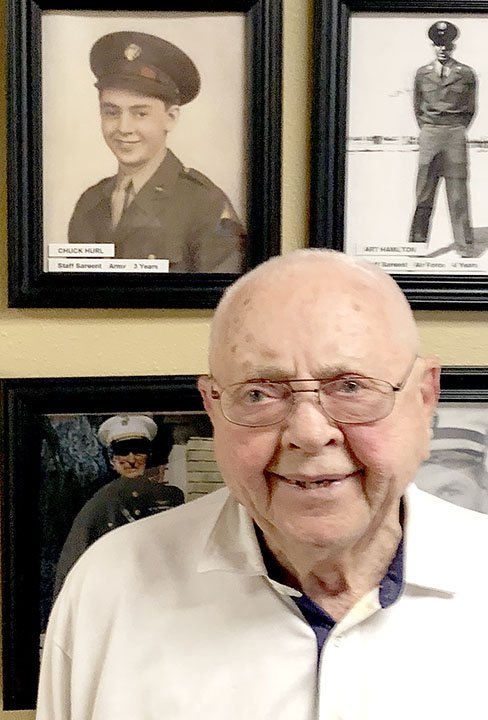When Charles Hurl started college in Pennsylvania, he signed up for the Air Force ROTC program, but it didn't work out. He was home for Christmas in Sharpsville, Penn., during his freshman year when he ran into the mayor. The mayor of Sharpsville also ran the local draft board and he told young Hurl not to bother returning to school.
Even today Hurl isn't sure why he was drafted into the Army instead of being allowed to enlist as an officer after college, but he took the mayor's advice and didn't go back to school. Within a few weeks, he was in 14th Armored Division learning about tanks.
He remembers an incident during training. He and a friend were allowed to travel to Kansas City on a Saturday night. They were on their way to the movies. Leaving the hotel, they were passing under an awning when they saw a Major General on his way in. Hurl remembers that his friend was nervous about encountering an officer, but he wasn't.
"We don't have to salute him," he told his friend. The awning meant that they were undercover and no salute was necessary. As the major general passed, he asked the two young privates why they didn't salute. Hurl responded that they didn't have to. The major general went back to the sidewalk, out from under the awning and saluted them, embarrassing Hurl and his friend. They returned the salute.
"I started at the bottom," he said. He was a ball gunner when he was wounded the first time in 1944. He was promoted while he was in the hospital and returned to his unit as a gunner, but then he was wounded a second time.
When General AP Smith, his commanding officer, came to visit Hurl in the hospital, he told him about his personal rule. Smith said if any of his soldiers were wounded twice they had a choice of going home and teaching recruits or being transferred to the unit's headquarters for a desk job.
Hurl thought about it and asked to return to his unit.
"I had no friends left at home or in headquarters," he explained. "All my friends were fighting in the front lines. I just didn't know anyone else and I didn't want to leave the guys I had been fighting with."
He returned to his unit as a tank commander.
The 14th Armored Division earned the nickname "Liberators" by freeing 250,000 prisoners of war, Hurl said. According to Wikipedia, the Division forced open the gates of Oflag XIII-B where they found a large contingent of Serbian and American officer prisoners. Next came Stalag XII-C where they found a large contingent of Allied enlisted men.
After more fighting, members of the Division approached Stalag VII-A where 130,000 Allied prisoners were freed. The Division is also credited with finding and liberating sub-camps of the Dachau concentration camp filled with Polish and Soviet civilians as well as two additional camps filled with Jewish prisoners.
Between the time the war ended and the Division returned home, Hurl was hospitalized again, this time for appendicitis. He missed the chance to go home with his division and when he was released after weeks in the hospital, no one could find his records.
He spent six weeks going back and forth between Paris and Munich, searching for his records. He was so well known along the route that the engineer on the train he rode invited him to ride up front and a soldier in Munich let him share his quarters. He never did find his records, but he was allowed to travel home with a regiment of Japanese American soldiers, many of whom had parents held in American camps.
Hurl came home and went back to college. He graduated as a civil engineer and went to work Chicago Bridge and Iron. The firm didn't build bridges or use iron, but Hurl had a long career that included everything from research to construction management. He and his wife had five children and the family lived in Brazil and later Germany as the kids were growing up.
They retired in Bella Vista after looking at retirement communities in Mexico. Hurl joined the Flytyers in 1991 and is still an active member. Several of his children have moved to the area too.
But like other World War Two veterans, Hurl didn't talk about the war very much. He didn't want to talk about the friends who were killed nearby both times he was wounded.
"I didn't think anyone should know about that," he said.
For his 85th birthday, his children arranged a family reunion and all of his children and grandchildren attended, along with his sister and her husband. One of his daughters arranged for his 10 grandchildren to interview him and, one by one, each of his grandchildren asked him questions. To Hurl's surprise, they all wanted to know about his military service. He didn't tell them everything, but he did start talking and he's not sure why. In the years since, he's opened up about the war.
Hurl is one of several World War II veterans living at Concordia.
General News on 11/07/2018

